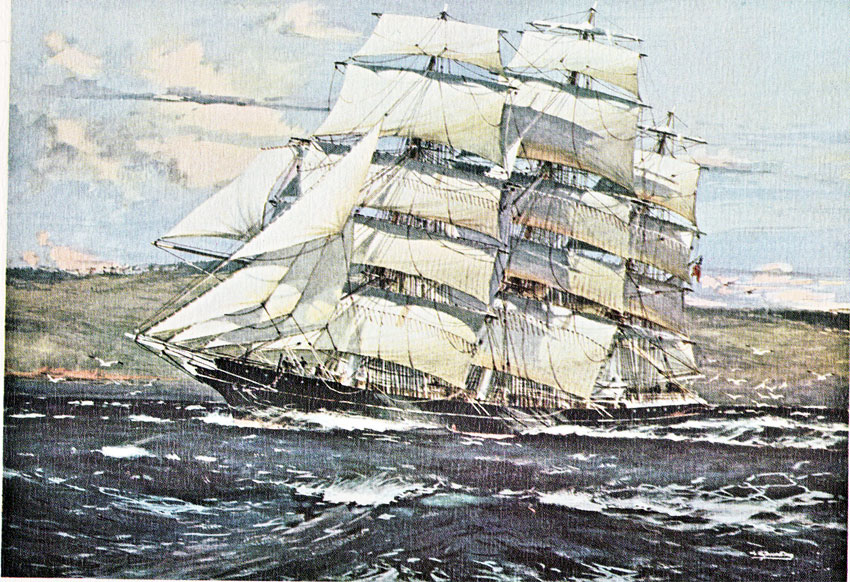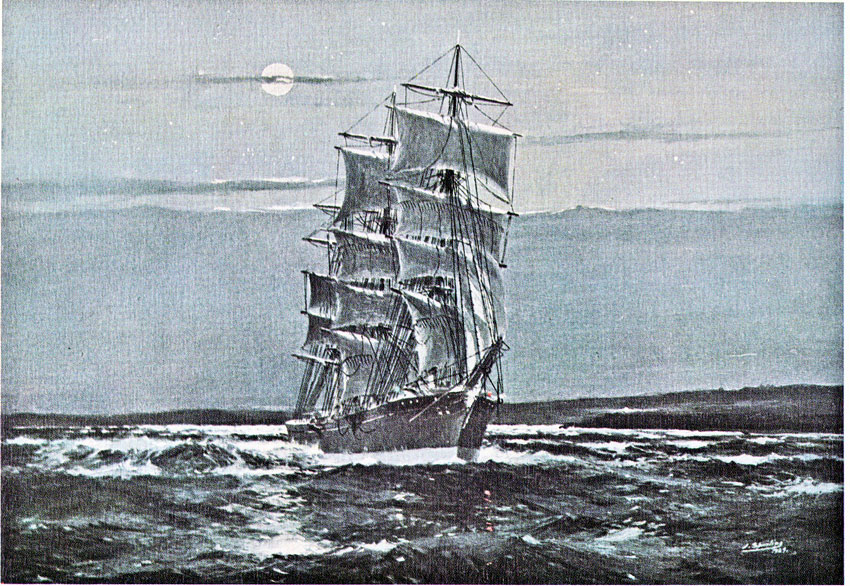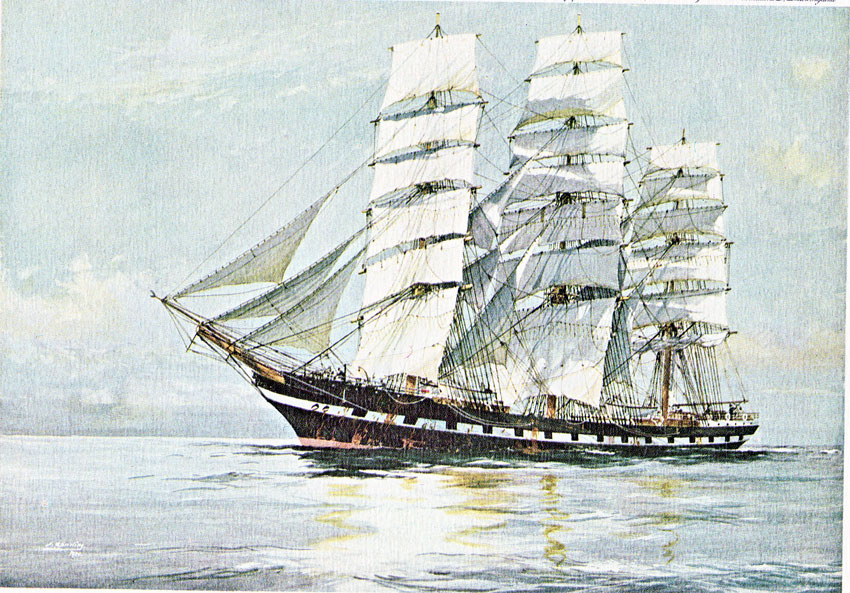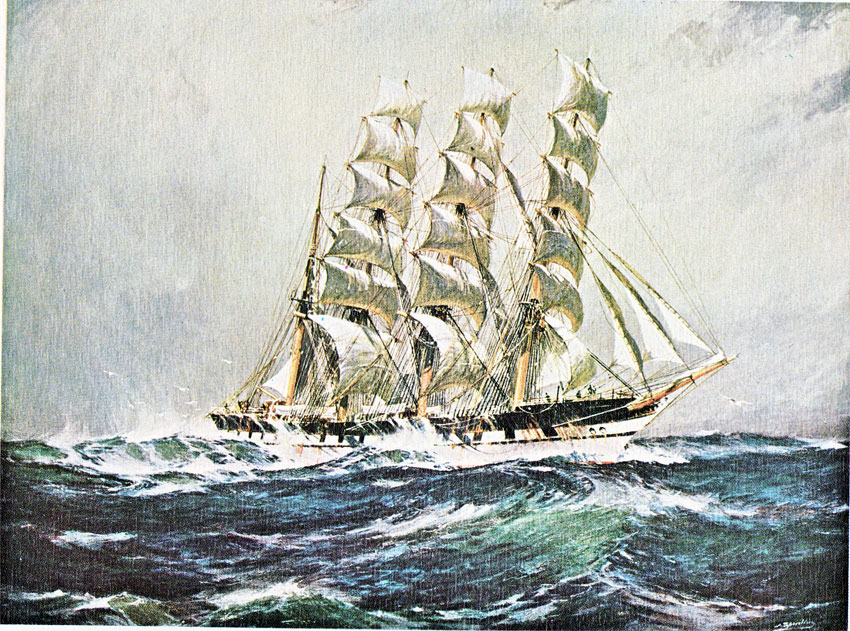(RETURN)
SAIL VOLUME III
V. GENERAL TRADERS
BRITISH MERCHANT (1880 - 1909) tonnage 1,742 gross
and 1,698 net, length 262ft 9in, beam 38ft 3in,
depth
23ft 3in.
Of iron construction, built by Harland & Wollf, Belfast, for
James
Beasley's British Shipowners
Co.
She made twelve voyages to
Melbourne, San Francisco
and Calcutta, and carried cargoes of coal , wheat
and
jute. In
1896, she was sold to German owners in Bremen and was renamed
ARTHUR FITGER. In 1908,
she
caught fire while at Seattle
and after the fire was sold and converted into a towing
barge. She came
to an
end in
1909 while being towed into Cordoba, Alaska, where as a
result of a pilotage error she went ashore and
was
a total loss.

GARFIELD (1882 - 1895), tonnage 2,347 gross
and 2,200 net, length 299ft 8in, beam 41ft 2in,
depth 24ft 8in.
Of steel construction, built by
Harland & Wollf, Belfast, for T.H.Ismay and W.Imrie
of the White
Star Line. At the time of her completion she was the largest fulled
rigged ship built.
She became
the flagship of the North West
Shipping Co. managed by Ismay and Imrie.She sailed
mainly in
the San Francisco grain trade but made six voyages
to
Calcutta and one to Melbourne.
In 1895,
on a voyage from Liverpool to
Valparaiso with a cargo of
coal she was abandoned on fire.
The burnt
hulk was towed into Coquimbo,
Chile, where she remained. .

EUPHROSYNE (1885 - 1911), tonnage 1,905 gross and
1,799 net, length 270ft 6in, beam 40ft,
depth 23ft 4in.
Of steel
construction by Robert Duncan,
Port Glasgow, for C.S. Caird. A powerful,
weatherly and
fast
ship, able to reach 13 knots and occasionally 15 knots. Hearly
voyages
illustrate
the pattern of
actity as a general trader. In her maiden
voyage she carryied coal from the Clyde to
San Fracico,
wheat
from there
to Lierpool, then salt to Calcutta and linseed from there to Australia,
coal to San
Francisco and grain to England. In 1907, she was sold to
Norwegian
owners. In 1911,
a steamer ran
into her in the English Channel.
The ship sank but the crew managed to get
away.

CALIFORNIA (1890 - 1927), tonnage 3,099 gross
and 2,901 net, length 392ft 3in, beam 45ft 2in.
depth 26ft 7in.
Constructed of steel, built by
Harland & Wollf, Belfast, for Ismay & Imrie Co of the
White
Star Line. As a four masted barque, she was built as a bulk carrier to
bring
wheat from the
West Coast of
North America to Great Britain. She was one of the
four last sailing ships built by
Harland &
Wollf. In 1890,
when new, she sailed from Liverpool to San Francisco in 130 days and
made the return
journey San Francisco to Liverpool in 1891 in
121days. In 1896, she was sold to
another
Liverpool firm who in
the following yesr sold her to Robert Sloman of Hamburg who
renamed
her ALSTER. In 1912, the vessel was sold with others of the
Sloman sailing ship fleet to
E.C.Schramm
& Co. and renamed CHRISTEL
VINNEN. The outbreak of World War I found
the vessel in
Valparaiso where she was interned, During internment the
crew did their
best to disable
her. She
was allocated to Italy after the war but
the Italians did not refit her. In 1926 she changed
hands and was
refitted
for the nitrate trade. In January 1927 she loaded 5,000 tons of
nitrates for
Norfolk
Virginia. She took 77 days to reach Panama and after
being towed through the Canal
stranded
on the Island of Old Providence
and was abandoned to the underwriters and was a total
loss.

ROSS-SHIRE (1891 - 1900), tonnage 2257 gross,
length289ft 1in, beam 41ft 2in, depth 24ft 4in. Of
steel
construction, built by Scott of Greenock for
Thomas Law's Scottish Shire Line. A four masted
barque built as
a cargo
carrier.in the five years from the end of the eighties which saw a
boom in sail
cargo carriers.
From Liverpool in February 1900, she made
an 84 day passage to Sydney, took on
a cargo of
4,000 tons of
coal at Newcastle, crossed the Pacific to Valparaiso in 41 days, then
went
to Caldera
where 2,400 tons of coal was discharged and
on to Pisagua to load nitrate for Britain.
On the night of
23rd
December 1900, at Pisagua, she had 750 tons of saltpetre on board and
500 tos
of coal still
tobe discharged. An explosion of gas set fire to
the ship. The ship went down and the
crew was saved.
.

(RETURN)




